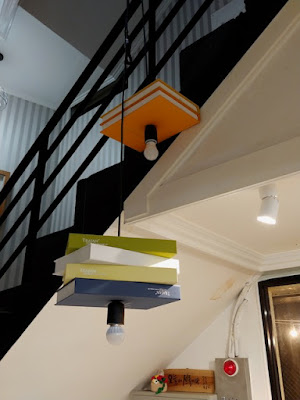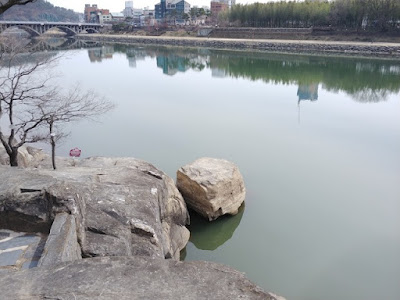This was the one city I was able to visit without pre-booking a place to stay, as I was taken right to a lovely guest house by my hosts. It was so much easier than all the legwork of researching hotels online, etc. And that's how you end up staying in a book-themed guest house!
Jinju is right on the Nam River, a tributary of the mighty and long Nakdong River that starts in the Taebaek Mountains in Gangwon Province, and empties into the sea in Busan.
Jinju had a great wall that enclosed a city full of private homes and everything you'd need, but it was cleared out so that the enclosed space has lots of wide open blank spaces for the public to gather during various festivals, memorials to the Koreans who were slaughtered by the Japanese, a museum, and other site I'm sure I missed.
Dr. Jo pointed out the black bamboo near the following shrine.
Nongae was a gisaeng who sacrificed herself to kill a Japanese general who was celebrating a Japanese invasion with dancing and drink. She lured a Japanese general onto a boulder, embraced him while dancing, and then threw them both into the river.
Apparently her portrait had to be redone because the original portrait was made by an artist who was later found to be a Japanese sympathizer.
This is the important detail of the story: the way that she managed to keep a hold of this drunk man as he likely struggled in the water to get out of her grasp was to lock her fingers together with the rings she wore that night.
This is right near that boulder.
And here is the boulder, which was later inscribed.
This is the site of the
Jinju National Museum, which for the most part reviews the history of the Japanese invasions of Korea of the late 16th century (the Imjin Wars).
This display of pottery is stunning from the galleries above.
And of course there was tons of stuff related to books and printing. Here's moveable type.
And woodblocks to illustrate books and on the top, a block that would be used likely to texture cover papers with subtle patterns.
A rubbing of a memorial inscription from the early 20th century. I love rubbings, and wish I had more opportunities to practice.
Before all of the Jinju sightseeing was the glorious driving around the mountains after our visit to Lee Sang-ok Traditional Hanji near Jirisan. I think this was taken from a "healing center" that was expressly made at a place that has some kind of positive vibrational energy. I'm sure people get a lot out of the complex but I think it's kind of sad that so much of the mountains behind me were excavated for that purpose. I'd think the woods and mountains alone would be healing enough.
But this was the first place Dr. Jo took all of us (not just me but the research team from Dr. Lee's project) after all the dak stripping, a beautiful Buddhist temple called
Seoamjeongsa (any Korean name with "sa" at the end indicates a temple. So it would be Seoamjeong Temple).
Guarding the entryway are the Four Heavenly Kings, each guarding a cardinal direction. They're magnificent and blend right into the surroundings.
After passing them, you pass through these walls that have moss and small trees growing from the crevices to this gateway.
I don't have a good full picture of the first main temple building you see as you emerge from that gateway, but it's gorgeous and a whole different color scheme than I have seen at other temples.
Besides the orangey tan, the stories depicted were a welcome sight, reminding me of visiting other similarly adorned buildings well over a decade ago.
It's a whole complex of nature and architecture, but this grotto was the most spectacular. The signs make it clear that you cannot take pictures so I refrained, which was kind of a relief. To be able to experience the incredible carvings inside without constant shooting was welcome. It was incredibly moving and Dr. Jo said it reminds you of how much humans are capable of doing. You can tell who is Buddhist by the way they enter and behave, and that was a great comfort as well, as I was not equipped to properly greet the figures inside. It made me think of the
Seokguram Grotto in Gyeongju (northeast of this one), which I've not been able to visit, but from what I could gather, this one was based on the one in Gyeongju.
There was even more to see beyond this, including camellia flowers that had already started to bloom, while the mountain vistas were stunning. If not for pandemic, we probably would have been able to enjoy the fresh mineral water as well.
After the team also joined us to see one final area, a bridge over water, they had to head back to the lab and Dr. Jo showed me a king's tomb. He is pointing out what this says and I'm not sure if he's aware I'm not advanced enough in Korean to read Chinese characters (
sadly, but life is short and if I spent all my time studying languages, I'd never make any paper).
This is his shot of the tomb area. It was brilliantly sunny that day, which was totally different from the next time I headed to the mountains two days later.
The next morning was when we visited the walled area inside of Jinju and the museum. But first we went to another temple, and I was so curious about the roof repair work. I had never seen this before and was shocked to learn that underneath the clay roof tiles is...dirt! I am not an architect or builder but this was fascinating to me, that the tiles sit on top of earth, and when parts of the roof start to leak, you go up and put more dirt down as the original stuff has settled.

Now I see these roofs and think of all the work that went into engineering and building them. Dr. Jo said that the dirt keeps the buildings warm, but the roofs are also heavy, which is why you need a strong wood structure underneath. It makes me think of how in Korea and the parts of Europe I've visited use pavers for their sidewalks, and how much more practical that is than American concrete. When tree roots or whatever cause them to lift, you only need to remove the portion being affected, instead of ripping out entire sections.
This was the windy road that Dr. Lee showed me on my last day, in the rain, as my sickness was mounting. I worked really hard not to lose the contents of my stomach but it was a challenge on this road.
After I had thrown up at a nearby winery (which explains why I have no pictures), he took me to the hanok maeul (traditional Korean building village) to try and see a huge piece of hanji that a past king or someone similarly important had graced with his calligraphy.
Sadly because of pandemic, it was closed and I could only try to peek between the cracks of the doors to look.
So as not to end with a closed door, which used to be a more common occurrence for me here when it comes to people not being willing to share information with me, here is one last image from Seoamjeongsa. The last several posts were devoted to less than four entire days of my life, but they were overflowing with abundance. Just one more trip to share to feel caught up.
Today I was inside almost the entire day because yellow dust levels were dangerously high. It launched me back into a bit of lockdown panic, but tomorrow I'll venture out even though it's not completely safe, likely double masked.
































































